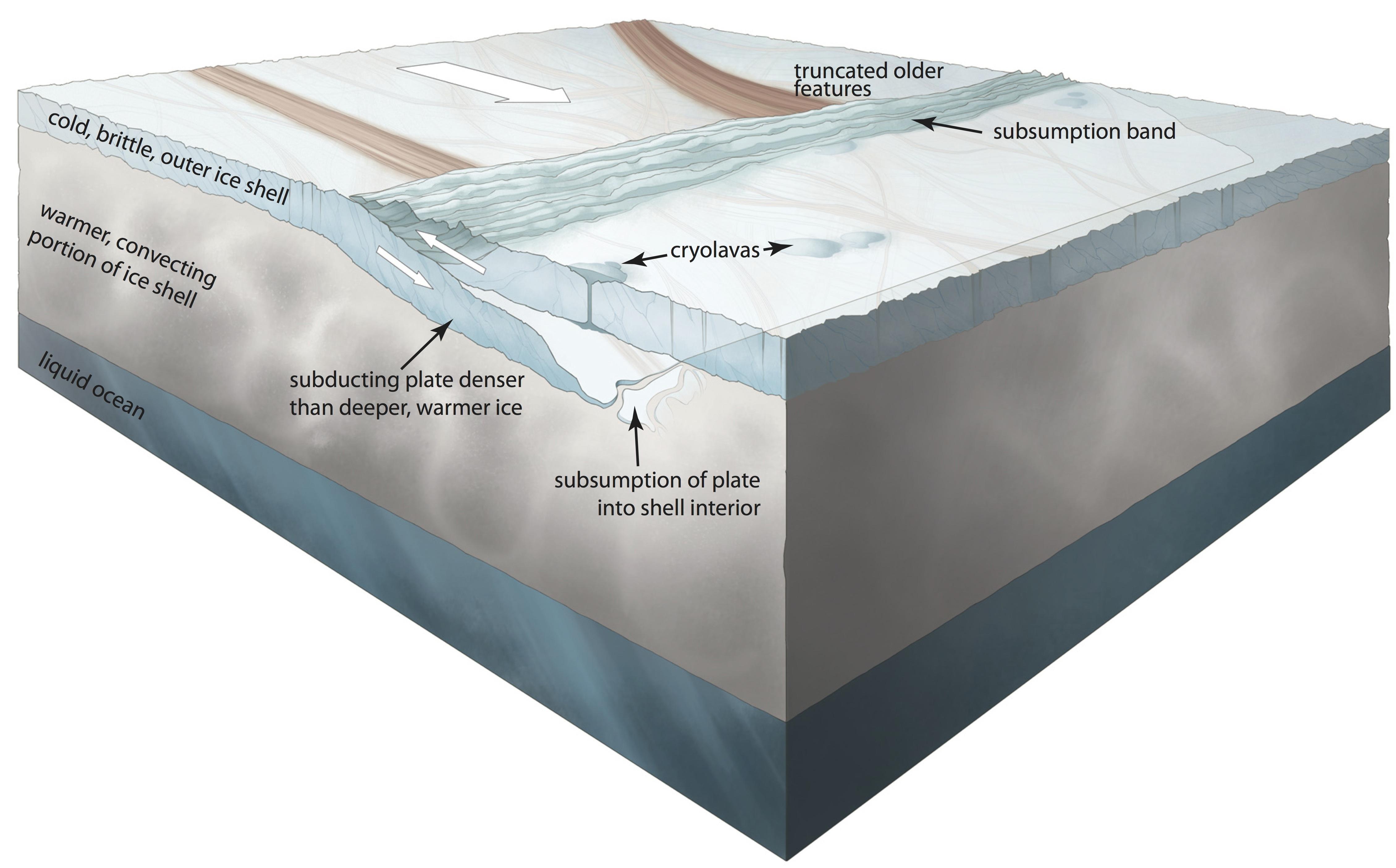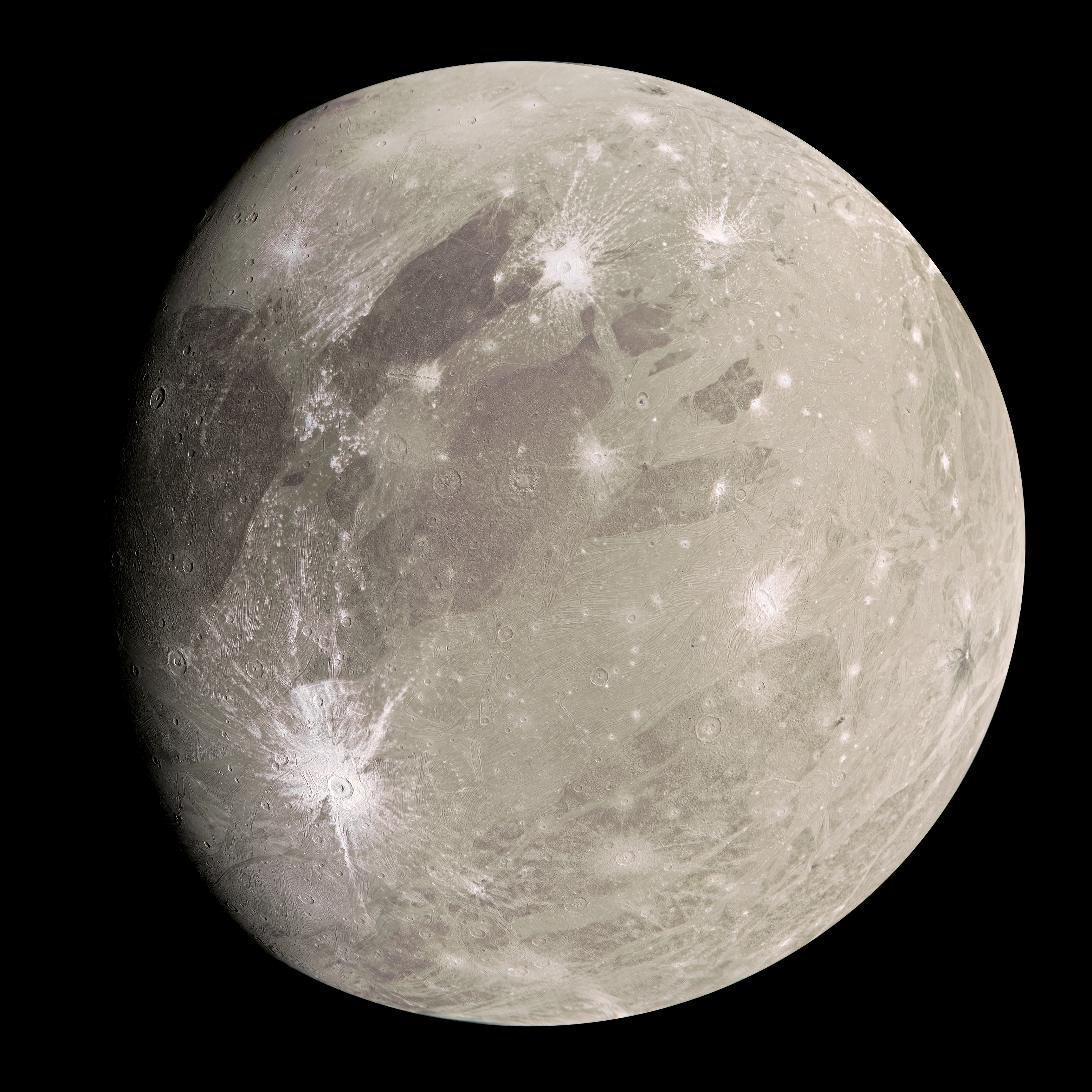|
Icy Moon
Icy moons are a class of natural satellites with surfaces composed mostly of ice. An icy moon may harbor an ocean underneath the surface, and possibly include a rocky core of silicate or metallic rocks. It is thought that they may be composed of ice II or other polymorph of water ice. The prime example of this class of object is Europa. Icy moons warmed by tides may be the most common type of celestial body in the galaxy to have liquid water, and thus the most likely type of object to possibly have water-based life. Some icy moons exhibit cryovolcanism, as well as geysers. The best studied example is Saturn's Enceladus. Orbits Most known large icy moons belong to giant planets, whose orbits lie beyond the Solar System's frost line; the remainder (such as Charon and Dysnomia) formed around dwarf planets such as Pluto and , typically in large impacts not unlike the impact thought to have formed Earth's moon. In the case of icy gas giant satellites, an additional requiremen ... [...More Info...] [...Related Items...] OR: [Wikipedia] [Google] [Baidu] |
Triton (moon)
Triton is the largest natural satellite of the planet Neptune. It is the only moon of Neptune massive enough to be list of gravitationally rounded objects of the Solar System, rounded under its own gravity and hosts a atmosphere of Triton, thin, hazy atmosphere. Triton orbits Neptune in a retrograde orbit—revolving in the opposite direction to the parent planet's rotation—the only large moon in the Solar System to do so. Triton is thought to have once been a dwarf planet from the Kuiper belt, gravitational capture, captured into Neptune's orbit by the latter's gravity. At in diameter, Triton is the list of natural satellites#List, seventh-largest moon in the Solar System, the second-largest planetary moon in relation to its primary (after Earth's Moon), and larger than all of the known dwarf planets. The mean density is , reflecting a composition of approximately 30–45% ice, water ice by mass, with the rest being mostly rock and metal. Triton is differentiated, with a c ... [...More Info...] [...Related Items...] OR: [Wikipedia] [Google] [Baidu] |
Natural Satellite
A natural satellite is, in the most common usage, an astronomical body that orbits a planet, dwarf planet, or small Solar System body (or sometimes another natural satellite). Natural satellites are colloquially referred to as moons, a derivation from the Moon of Earth. In the Solar System, there are six planetary satellite systems containing 418 known natural satellites altogether. Seven objects commonly considered dwarf planets by astronomers are also known to have natural satellites: , Pluto, Haumea, , Makemake, , and Eris. As of January 2022, there are 447 other minor planets known to have natural satellites. A planet usually has at least around 10,000 times the mass of any natural satellites that orbit it, with a correspondingly much larger diameter. The Earth–Moon system is a unique exception in the Solar System; at 3,474 kilometres (2,158 miles) across, the Moon is 0.273 times the diameter of Earth and about of its mass. The next largest ratios are the N ... [...More Info...] [...Related Items...] OR: [Wikipedia] [Google] [Baidu] |
Galilean Moons
The Galilean moons (), or Galilean satellites, are the four largest moons of Jupiter. They are, in descending-size order, Ganymede (moon), Ganymede, Callisto (moon), Callisto, Io (moon), Io, and Europa (moon), Europa. They are the most apparent magnitude, readily visible Solar System objects after Saturn, the dimmest of the classical planets; though their closeness to bright Jupiter makes naked-eye observation very difficult, they are readily seen with common binoculars, even under night sky Bortle scale, conditions of high light pollution. The invention of the telescope allowed astronomers to discover the moons in 1610. Through this, they became the first Timeline of discovery of Solar System planets and their moons, Solar System objects discovered since humans have started tracking the classical planets, and the first objects to be found to orbit any planet beyond Earth. They are planetary-mass moons and among the List of Solar System objects by size, largest objects in the Sola ... [...More Info...] [...Related Items...] OR: [Wikipedia] [Google] [Baidu] |
Tectonics On Icy Moons
Tectonic activity has been studied on several icy moons. Background Igneous activity on icy moons can be defined as the melting, ascension, and solidification of liquids, particularly water and its ice polymorphs. Tectonic features on icy lithospheres occur by global and regional stresses acting on the moon's interior. Fractures in the icy lithosphere influence the mechanisms by which the lithosphere reacts to stress. An unfractured ice lithosphere has a greater shear strength than tensile strength, and accordingly, compressional deformation must occur by shear failure and cause thrust and strike-slip faulting. Conversely, prefractured ice has much less shear strength, and extensional stress will produce normal faults and graben. Residual heat from accretion is one possible source of internal heat for icy moons. But only moons with radii greater than about 2000 km are thought to be massive enough to melt pure water-ice in the outer layers. Tidal heating and the decay of rad ... [...More Info...] [...Related Items...] OR: [Wikipedia] [Google] [Baidu] |
Ice Planet
An ice planet or icy planet is a type of planet with an icy surface of volatiles such as water, ammonia, and methane. Ice planets consist of a global cryosphere. Under a geophysical definition of planet, the small icy worlds of the Solar System qualify as icy planets. These include most of the planetary-mass moons, such as Ganymede, Titan, Europa, Enceladus, and Triton; dwarf planets Pluto, Orcus, Haumea, Makemake, Quaoar, Sedna, Gonggong, and Eris; and the largest comets. In June 2020, NASA scientists reported that it is likely that exoplanets with oceans, including some with oceans that may lie beneath a layer of surface ice, may be common in the Milky Way galaxy, based on mathematical modeling studies. OGLE-2005-BLG-390Lb, first observed in 2005, is a possible ice planet. Characteristics and habitability An ice planet's surface can be composed of water, methane, ammonia, carbon dioxide (known as "dry ice"), carbon monoxide, nitrogen, and other volatiles, dependin ... [...More Info...] [...Related Items...] OR: [Wikipedia] [Google] [Baidu] |
Ocean Planet
An ocean world, ocean planet or water world is a type of planet or natural satellite that contains a substantial amount of water in the form of oceans, as part of its hydrosphere, either beneath the planetary surface, surface, as subsurface oceans, or on the surface, potentially submerging all dry land. The term ''ocean world'' is also used sometimes for astronomical bodies with an ocean composed of a different fluid or thalassogen, such as lava (the case of Io (moon), Io), ammonia (in a eutectic mixture with water, as is likely the case of Titan (moon), Titan's inner ocean) or hydrocarbons (like on Titan's surface, which could be the most abundant kind of exosea). The study of extraterrestrial oceans is referred to as planetary oceanography. Earth is the only astronomical object known to presently have bodies of liquid water on its surface, although subsurface oceans are suspected to exist on Jupiter's moons Europa (moon), Europa and Ganymede (moon), Ganymede and Saturn's mo ... [...More Info...] [...Related Items...] OR: [Wikipedia] [Google] [Baidu] |
Umbriel
Umbriel () is the third-largest moon of Uranus. It was discovered on October 24, 1851, by William Lassell at the same time as neighboring moon Ariel. It was named after a character in Alexander Pope's 1712 poem '' The Rape of the Lock''. Umbriel consists mainly of ice with a substantial fraction of rock, and may be differentiated into a rocky core and an icy mantle. The surface is the darkest among Uranian moons, and appears to have been shaped primarily by impacts, but the presence of canyons suggests early internal processes, and the moon may have undergone an early endogenically driven resurfacing event that obliterated its older surface. Covered by numerous impact craters reaching in diameter, Umbriel is the second-most heavily cratered satellite of Uranus after Oberon. The most prominent surface feature is a ring of bright material on the floor of Wunda crater. This moon, like all regular moons of Uranus, probably formed from an accretion disk that surrounded the ... [...More Info...] [...Related Items...] OR: [Wikipedia] [Google] [Baidu] |
Miranda (moon)
Miranda, also designated Uranus V, is the smallest and innermost of Uranus's five round natural satellite, satellites. It was discovered by Gerard Kuiper on 16 February 1948 at McDonald Observatory in Texas, and named after Miranda (The Tempest), Miranda from William Shakespeare's play ''The Tempest''. Like the other large moons of Uranus, Miranda orbits close to its planet's equatorial plane. Because Uranus orbits the Sun on its side, Miranda's orbit is nearly perpendicular to the ecliptic and shares Uranus's extreme seasonal cycle. At just in diameter, Miranda is one of the smallest closely observed objects in the Solar System that might be in hydrostatic equilibrium (spherical under its own gravity), and its total surface area is roughly equal to that of the U.S. state of Texas. The only close-up images of Miranda are from the ''Voyager 2'' probe, which made observations of Miranda during its Uranus flyby in January 1986. During the flyby, Miranda's southern hemisphere po ... [...More Info...] [...Related Items...] OR: [Wikipedia] [Google] [Baidu] |
Mimas (moon)
Mimas, also designated Saturn I, is the seventh-largest natural satellite of Saturn. With a mean diameter of , Mimas is the smallest astronomical body known to be roughly rounded in shape due to its own gravity. Mimas's low density, 1.15 g/cm3, indicates that it is composed mostly of water ice with only a small amount of rock, and study of Mimas's motion suggests that it may have a liquid ocean beneath its surface ice. The surface of Mimas is heavily cratered and shows little signs of recent geological activity. A notable feature of Mimas's surface is Herschel, one of the largest craters relative to the size of the parent body in the Solar System. Herschel measures across, about one-third of Mimas's mean diameter, and formed from an extremely energetic impact event. The crater's name is derived from the discoverer of Mimas, William Herschel, in 1789. The moon's presence has created one of the largest 'gaps' in Saturn's ring, named the Cassini Division, due to orbital ... [...More Info...] [...Related Items...] OR: [Wikipedia] [Google] [Baidu] |
Deposit (geology)
Deposition is the geological process in which sediments, soil and rocks are added to a landform or landmass. Wind, ice, water, and gravity transport previously weathered surface material, which, at the loss of enough kinetic energy in the fluid, is deposited, building up layers of sediment. This occurs when the forces responsible for sediment transportation are no longer sufficient to overcome the forces of gravity and friction, creating a resistance to motion; this is known as the null-point hypothesis. Deposition can also refer to the buildup of sediment from organically derived matter or chemical processes. For example, chalk is made up partly of the microscopic calcium carbonate skeletons of marine plankton, the deposition of which induced chemical processes ( diagenesis) to deposit further calcium carbonate. Similarly, the formation of coal begins with the deposition of organic material, mainly from plants, in anaerobic conditions. Null-point hypothesis The null-point ... [...More Info...] [...Related Items...] OR: [Wikipedia] [Google] [Baidu] |
Liquid Methane
Methane ( , ) is a chemical compound with the chemical formula (one carbon atom bonded to four hydrogen atoms). It is a group-14 hydride, the simplest alkane, and the main constituent of natural gas. The abundance of methane on Earth makes it an economically attractive fuel, although capturing and storing it is difficult because it is a gas at standard temperature and pressure. In the Earth's atmosphere methane is transparent to visible light but absorbs infrared radiation, acting as a greenhouse gas. Methane is an organic compound, and among the simplest of organic compounds. Methane is also a hydrocarbon. Naturally occurring methane is found both below ground and under the seafloor and is formed by both geological and biological processes. The largest reservoir of methane is under the seafloor in the form of methane clathrates. When methane reaches the surface and the atmosphere, it is known as atmospheric methane. The Earth's atmospheric methane concentration h ... [...More Info...] [...Related Items...] OR: [Wikipedia] [Google] [Baidu] |
Titan (moon)
Titan is the largest moon of Saturn and the List of Solar System objects by size, second-largest in the Solar System. It is the only Natural satellite, moon known to have an atmosphere denser than the Atmosphere of Earth, Earth's and is the only known object in space—other than Earth—on which there is clear evidence that stable bodies of liquid exist. Titan is one of seven List of gravitationally rounded objects of the Solar System, gravitationally rounded moons of Saturn and the second-most distant among them. Frequently described as a Planetary-mass moon, planet-like moon, Titan is 50% larger in diameter than Earth's Moon and 80% more Mass, massive. It is the second-largest moon in the Solar System after Jupiter's Ganymede (moon), Ganymede and is larger than Mercury (planet), Mercury; yet Titan is only 40% as massive as Mercury, because Mercury is mainly iron and rock while much of Titan is ice, which is less dense. Discovered in 1655 by the Dutch astronomer Christiaan ... [...More Info...] [...Related Items...] OR: [Wikipedia] [Google] [Baidu] |









